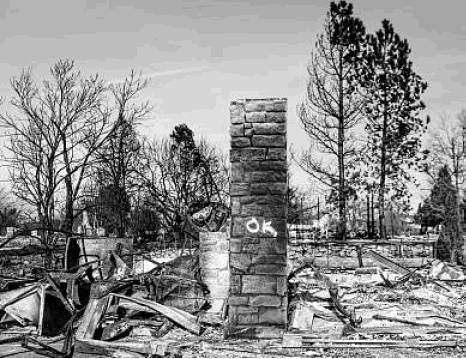We dodged a wildfire, but what’s to stop more blazes?
By Micaela Edelson
BOULDER COUNTY, Colo. — I woke to the wind singing against the southern window of the old farmhouse on Thursday last week. In the distance, horses were whinnying.
It was 11:45 a.m. when the neighbor knocked on the door.
“Did you see the smoke?” We had not. “I called the firefighters, and they’re on their way.”
Light smoke billowed behind the tree line. It was still south of Highway 36. After the initial shock, my roommate and I calmly packed and readied for a departure we weren’t sure would be needed. We watched light gray plumes turn dark brown. Then we saw the flames, but the smoke was blowing to the east, and I was grateful. Northward would have been right at us. Later that evening, I wouldn’t be sure what to be grateful for.
Within an hour, the fire seemed to slow down. The smoke was light gray again, flames no longer visible. We watched from the back door. Lunchtime entertainment.
Then, easy as breathing, the fire blew up again. Racing over the hill to the east. Neighbors were getting their horses to safety. We left, too.
This year the Colorado front range was parched. December was warm — Christmas without jackets. Dry grass was the tinder. Then came the wind, up to 110 mph, spreading sparks of unknown origin. Several other grass fires erupted that day. But only the one called the Marshall Fire — the one visible from my backyard on Dec. 30, the one my neighbor reported and the one I thought had slowed within an hour — ravaged on.
I have been acquainted with wildfires before. In September 2020, I watched from my childhood home in Salem, Ore., as blue skies succumbed to thick gray smoke that then turned dark crimson. Nine people were killed, more than 1 million acres burned, more than 4,100 homes were lost, half a million evacuated. But, luckily, I sat safe in my living room, cursing the ash falling outside and lamenting a climate-fated future.
The Marshall Fire felt different. Maybe because, from the porch, I could see the flames devouring familiar land. Maybe because a wildfire in winter is so strange.
The blaze kept roaring to the east, to Louisville and Superior — towns of tens of thousands of families. Lots of commuters and dogs — suburban glory. Three people are missing and feared dead in the Marshall Fire. Nearly 1,000 homes destroyed. My roommate’s workplace burned.
We drove three miles in the opposite direction. Unsure about the fate of our quaint farmhouse. The property’s owner had conducted controlled burns during the summer to deprive a wildfire of fuel. Had that been protection enough?
After the adrenaline rush of packing, driving, phoning, warning, a kind of stupor sets in. Then comes the sad sense of the widespread destruction.
Whole lives combusted in an instant. People at work who had to flee, unable to return home to collect precious mementos. Others who, moments before the flames arrived, swept up children and pets and are now hurtling toward uncertain new lives. This region could be threatened for generations as climate change alters the world.
What about the elderly? The disabled? The unhoused? The carless? How did they fare, how will they fare? I could have lost my home, but I have a car I was able to pack with belongings, and I have a remote job that will allow me to continue working. Along with grief comes guilt.
According to an online map of the wildfire, the farmhouse was right on the edge of its reach. Had the house survived? After two days, we were able to return. The fire line had stopped 100 yards from the backdoor. We walked the blackened pasture, stepping over tire tracks left by emergency vehicles, past winding lines of mounded dirt left by moles fleeing underground. At the back of the pasture, we could see a neighborhood in the distance. Half of the houses were destroyed.
But ours still stands. Was it just luck, a trick of the wind? Maybe the summer burns had done their job. Would the house be safe next time?
Now it’s snowing in Boulder County. The white blankets the charred land — in places, it almost looks like Christmas. But the snow can’t hide the blackened ruins, can’t conceal the menace. Winter fire will come again.
Micaela Edelson is an environmental writer based in Boulder, Colo., at the Oakley Art House residency. This piece was published by the Washington Post.
